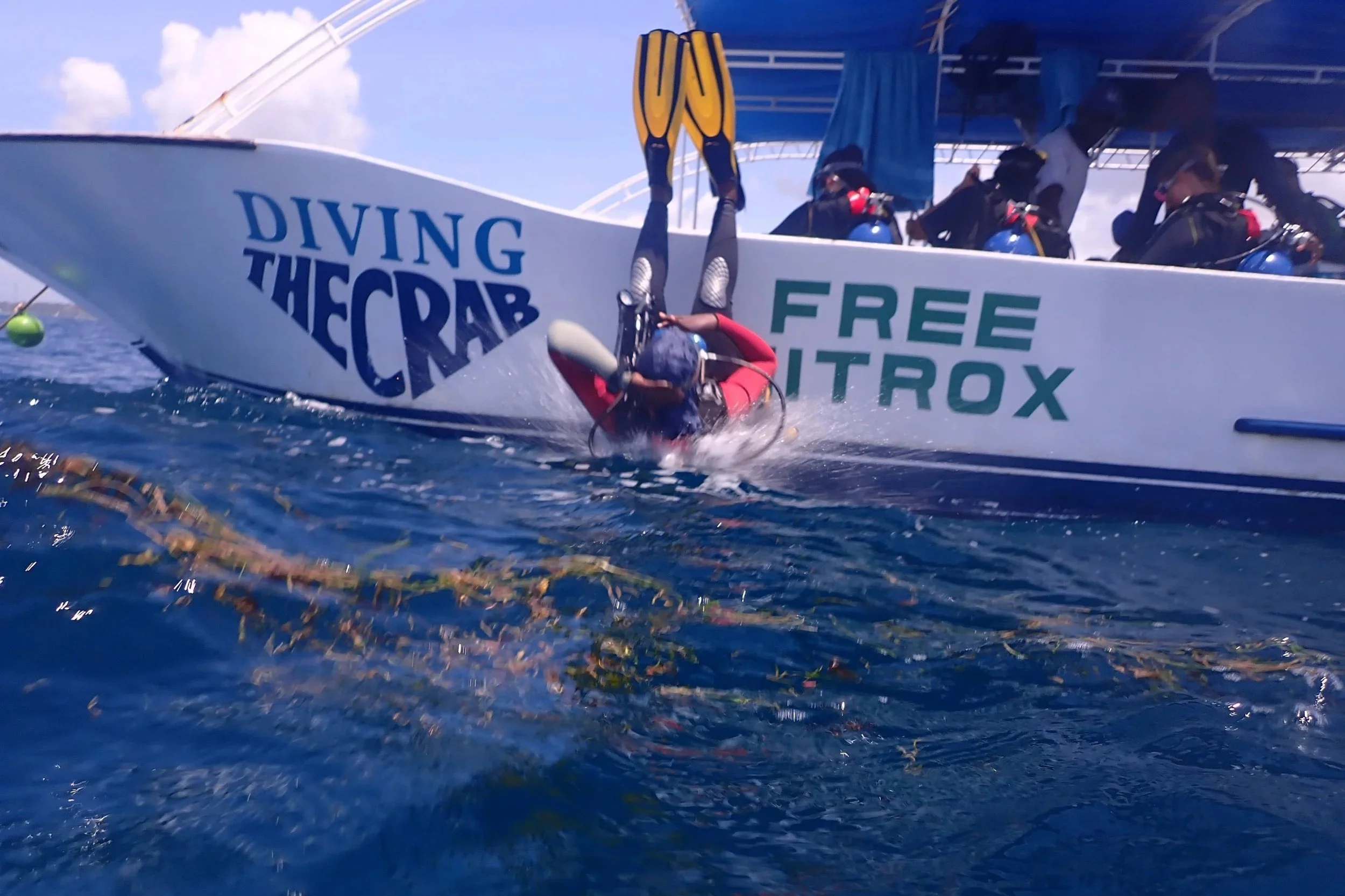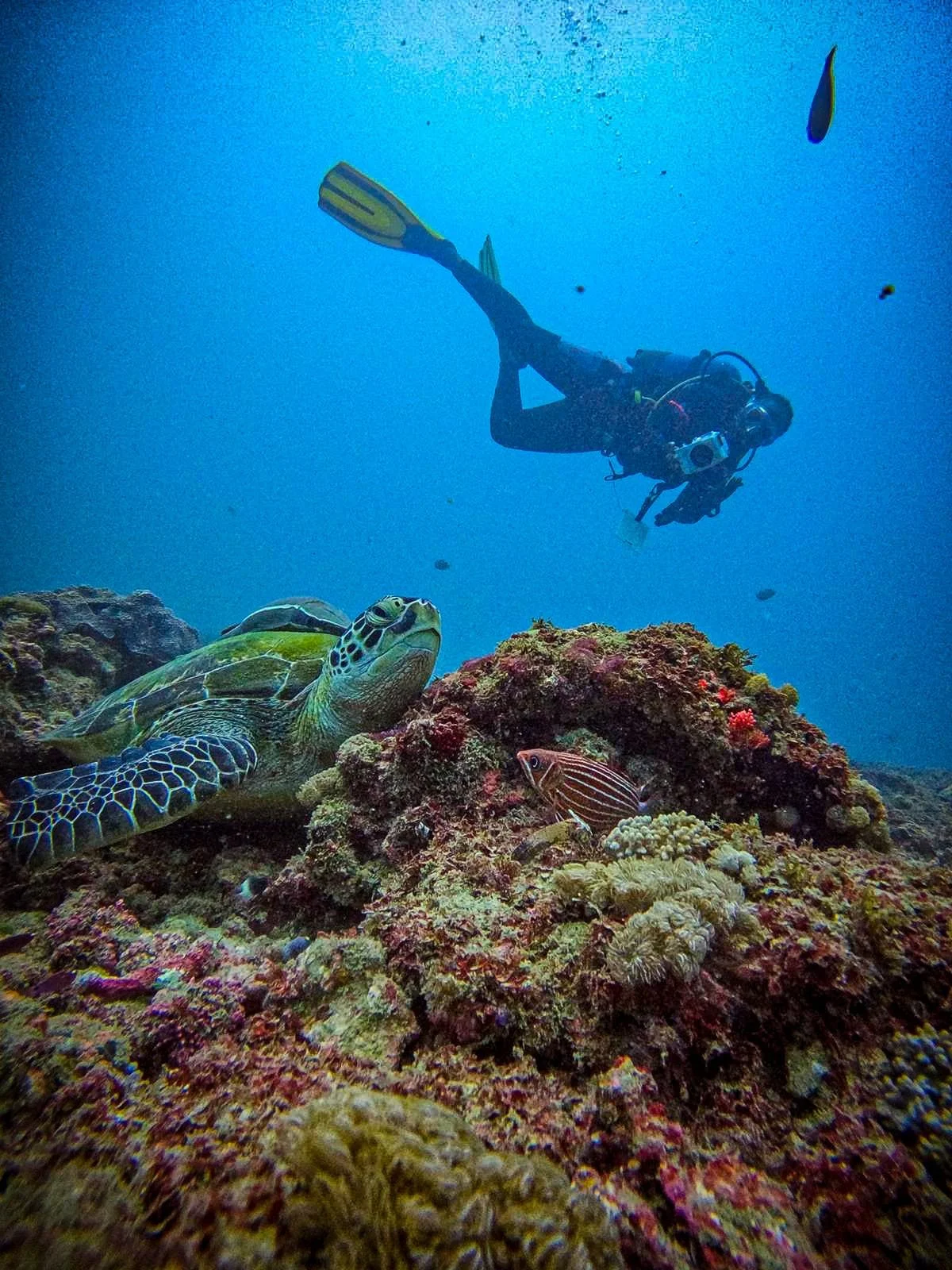The Kenyan Women at the Frontlines of Sea Turtle Conservation
A new generation of women is reshaping ocean conservation on Kenya’s coast, challenging cultural traditions and furthering scientific documentation.
Leah Mainye dives backward into the Indian Ocean on Kenya’s south coast to conduct research and documentation of sea turtles in August 2025. Credit: Keit Silale for More to Her Story
It is barely 8 a.m. at a dive center on Kenya’s south coast. A group of divers adjusts the straps of their wetsuits while others shuffle between piles of gear. Among them is Leah Mainye, steady and focused as she runs a final check on her oxygen tank. She is part of the lead conservation team guiding the day’s dive — the group whose expertise keeps everyone grounded beneath the waves.
Before departure, the team gathers in the briefing area. Mainye walks them through the day’s objectives, how to move carefully in the water, how to maintain a respectful distance from marine life, and what to record during the dives. Her tone is calm but firm, indicating this is not just a dive but a mission grounded in scientific documentation and conservation.
After the briefing, the cadre heads out for the day’s work. The Indian Ocean is calm, the sun already heating the wooden deck as the vessel cuts through turquoise water. Along this south coastline are more than 25 dive sites, each with its own character: coral reefs buzzing with fish, patches of seagrass swaying like wind-beaten meadows, and sandy stretches where turtles pause to feed and rest. Depending on the currents and the day’s objectives, the team selects its site.
A moment later, the divers roll down into the blue ocean. The chatter from the boat fades. Bubbles rise past her mask as she steadies the camera in her hands. This is where Mainye’s work begins.
“When I dive, I record everything I can about turtles, its species, behavior, whether it’s swimming, resting, foraging, or even at a cleaning station,” she said. “Turtles are naturally shy, so patience is key to photographing them.”
After a full day of diving and research, the divers head back to their respective offices. Each photograph they took is then scored for clarity, focus, and lighting before being added to their catalogue. Once the turtle pictures are verified, they are uploaded into a database used by researchers worldwide to track sea turtle populations and migration patterns.
Mainye’s journey to marine science didn’t begin underwater, but in front of a television set. Growing up, she was mesmerized by the divers portrayed in National Geographic documentaries. “Those documentaries caught my attention and made me want to take action.”
Photo (right): Mainye monitors sea turtles off of Kenya’s southern coast in August 2025. Credit: Olive Ridley Project Kenya
Her first real encounter with a sea turtle came years later, during a university dive after earning an Open Water certification. She was so focused on controlling her breathing and buoyancy that she almost missed the turtle gliding past her. “I nearly hit it,” she said. “[At] that moment, the documentaries became real. I wasn’t just watching anymore. I was in it.”
Today, six years into her role as a marine science diver and the chairperson of Olive Ridley Project Kenya, Mainye has built a career around those ancient reptiles. What started as a fascination has evolved into a purpose.
Sea turtles have existed for more than 100 million years, yet their resilience is being tested as never before: The IUCN Red List classifies six of the world’s seven turtle species as threatened. Populations of hawksbills, the species often spotted on Kenya’s reefs, have fallen by more than 80 percent over the last decade.
The Kenyan coast is home to five species of sea turtle: green turtles, hawksbill, olive ridley, loggerhead, and leatherback. All of them, endangered. The Olive Ridley Project’s data show that entanglement in discarded fishing nets, known as “ghost gear,” remains one of the greatest threats to turtles in this region. Plastic waste, poaching, and the loss of nesting beaches due to overdevelopment are also waking threats. “They graze on seagrass beds, keeping them healthy; and they help coral reefs stay resilient. Protecting turtles is protecting the ocean itself,” said Mainye.
The truth of that statement is palpable for Fatuma Salim, 28, who lives in a fishing village close to where Mainye works.
“As a girl, I remember the smell of turtle meat roasting over the fire,” she said. “It was a delicacy in my community. Eating turtle was normal. No one ever asked if it was wrong.”
According to the Kenya Wildlife Service (KWS), the consumption of turtle products remains deeply rooted along the Kenyan coast. A single clutch of eggs can sell for as much as USD $8, turtle oil trades for around USD $10 per liter, and carapaces — a turtle’s hard upper shell — are sold for anywhere between USD $8 and USD $20. By comparison, small-scale fishers often earn less than $4 on a slow day at sea, meaning a single sale of turtle products could equal several days’ wages.
One day, Mainye invited Salim and other members of her fishing community to learn how sea turtles were critically endangered, with its population dwindling with each fisherman’s catch. “Seeing Leah’s photos of the same turtles identified over the years, it hit me. They were individuals, survivors. We were erasing them.”
Fatuma Salim (center) with her team of beach management workers in Diani Beach, Kenya, in August 2025. Credit: Olive Ridley Project Kenya
Now, Salim is known across her village as a kind of "turtle ambassador,” said Salim. She’s the person to call when a turtle is caught in a fisherman’s net. “Before, the turtle would have been killed for meat,” Fatuma said. “Now, fishers ring me. I go straight to them, show them how to untangle it, and we release it together.”
Her methods of advocacy are as practical as they are creative. Convincing older men in her community has been her greatest challenge. “As a young woman, sometimes they don’t listen. They laugh or tell me I’m wasting time fighting a tradition,” she said. But she found a powerful ally: children.
“When I teach kids about turtles, they run home and tell their parents. Some refuse to eat turtle meat, saying, ‘Teacher Fatuma told us it’s endangered, we can’t eat it!’ Parents who ignored me listen to their own children. That is how the message spreads.”
For Mainye, Fatuma’s transformation is proof of concept. “Conservation can’t succeed if local people are left out,” she said. “Fatuma shows what happens when communities are part of the solution.”
While community ambassadors carry the message along the shoreline, experts stress that policy and science must walk hand in hand.
Dr. Judy Wakhungu, Kenya’s former Minister of Environment and a scientist, saw firsthand how plastic pollution was strangling marine life. “For turtles, a single plastic bag can be a death sentence,” she said. “They mistake it for jellyfish, ingest it, and suffer slow, painful deaths.”
Her tenure was marked by Kenya’s landmark 2017 ban on single-use plastic bags, celebrated globally as among the world’s boldest environmental policies. “It was not an easy fight,” she admits. “But it was necessary. Marine conservation cannot exist in isolation; it must be backed by strong, enforceable policy,” she said.
Wakhungu now champions community-driven approaches that heal ecosystems while strengthening livelihoods, just like what Mainye is doing in sea turtle conservation.
Photo (left) Mainye recording sea turtle sightings off of Kenya’s southern coast in August 2025. Credit: Olive Ridley Project Kenya
Globally, sea turtles are an indicator species, their survival reflecting the health of entire marine ecosystems. Hawksbill populations are down more than 80 percent. Leatherbacks, known by researchers as the ocean’s “gentle giants”, have declined nearly 40 percent in three generations.
This makes the work on Kenya’s coast all the more urgent. Lilian Mulupi, marine programme officer at the International Fund for Animal Welfare (IFAW), warns that the threats are escalating. “Ghost nets are deadly. Climate change is warming seas and reshaping nesting grounds. If turtles cannot adapt, ecosystems collapse. When we protect turtles, we protect fisheries, reefs, and coastal resilience.
Mulupi highlights ongoing collaborations with the Olive Ridley Project to better understand turtle populations. According to her, one of the biggest challenges in turtle conservation is the lack of reliable data. “Without proper records on their populations, behaviors, and migration routes, it becomes very difficult to design effective protection measures. Many communities along the coast also don’t fully understand the ecological importance of turtles, which makes awareness and education just as critical as field research,” she said.
To bridge this gap, Mainye is taking research further by leveraging technology. Using a high-resolution camera and specialized software, she catalogs turtles through the unique scale patterns on their faces, which are much like human fingerprints.
This digital identification system allows researchers to track individual turtles across years and locations, monitor their health, and study the spread of diseases such as fibropapillomatosis. The approach is transforming how conservation is done: what once required nearly eight months of snorkel surveys along a 30-kilometer reef can now be achieved in a single week with drones.
She recalls one drone survey that revealed a turtle entangled in fishing nets without the fisherman’s knowledge. “We were able to act immediately,” she explained. “The fisher came, we worked together, and that turtle swam free. Without the drone, it would have died unnoticed.”
Such tools have given conservationists like Mainye a broader view of the threats and the resilience of sea turtles. “In a single dive, we can now identify 20 to 50 turtles,” Mainye said. “That’s more than we used to document in an entire month. Technology has given us eyes underwater, and that knowledge is our best defense in marine conservation.”
Conservation is rarely straightforward. Mainye has known heartbreak, like finding a dead turtle she had tracked for months, its shell cut by fishing gear. But she has also known triumph: releasing rescued turtles back into the surf and even freeing a stranded dolphin.
“Those moments of life, of seeing something swim free again, make everything worth it.” She said.
As evening falls, Mainye is often still at her desk, cataloguing photographs or mentoring the next wave of turtle conservationists. In her, the ocean has found both scientist and diver; in Fatuma, it has gained a defender forged from change. Together, their work is stitched into a broader collective effort that includes policy pioneers like Judy Wakhungu and global scientists fighting for the same cause.
“The ocean gives us life,” Mainye said, “If we lose turtles, we lose far more than a species. We lose balance. We lose ourselves.”





